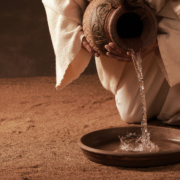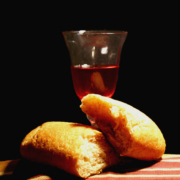MAUNDY THURSDAY
 The Thursday in Holy Week. It is part of the Triduum, or three holy days before Easter. It comes from the Latin mandatum novum, “new commandment,” from Jn 13:34. The ceremony of washing feet was also referred to as “the Maundy.” Maundy Thursday celebrations also commemorate the institution of the eucharist by Jesus “on the night he was betrayed.” Egeria, a fourth-century pilgrim to Jerusalem, describes elaborate celebrations and observances in that city on Maundy Thursday. Special celebration of the institution of the eucharist on Maundy Thursday is attested by the Council of Hippo in 381. The Prayer Book liturgy for Maundy Thursday provides for celebration of the eucharist and a ceremony of the washing of feet which follows the gospel and homily. There is also provision for the consecration of the bread and wine for administering Holy Communion from the reserved sacrament on Good Friday. Following this, the altar is stripped and all decorative furnishings are removed from the church. (https://episcopalchurch.org/library/glossary/maundy-thursday). An Episcopal Dictionary of the Church is a wealth of valuable information.
The Thursday in Holy Week. It is part of the Triduum, or three holy days before Easter. It comes from the Latin mandatum novum, “new commandment,” from Jn 13:34. The ceremony of washing feet was also referred to as “the Maundy.” Maundy Thursday celebrations also commemorate the institution of the eucharist by Jesus “on the night he was betrayed.” Egeria, a fourth-century pilgrim to Jerusalem, describes elaborate celebrations and observances in that city on Maundy Thursday. Special celebration of the institution of the eucharist on Maundy Thursday is attested by the Council of Hippo in 381. The Prayer Book liturgy for Maundy Thursday provides for celebration of the eucharist and a ceremony of the washing of feet which follows the gospel and homily. There is also provision for the consecration of the bread and wine for administering Holy Communion from the reserved sacrament on Good Friday. Following this, the altar is stripped and all decorative furnishings are removed from the church. (https://episcopalchurch.org/library/glossary/maundy-thursday). An Episcopal Dictionary of the Church is a wealth of valuable information.
Now for more tidbits from https://www.timeanddate.com/holidays/common/maundy-thursday below.
The day is also known as Passion Thursday, Paschal Thursday or Sheer (or Shere) Thursday. It is the day before Good Friday and occurs during Holy Week.
Many Catholic and Anglican churches continue traditional Maundy Thursday rites that may include handing out special coins known as “Maundy money” to the aged and poor. Churches may also have the blessing of holy oil and feet washing as part of their Maundy Thursday service. Some churches have a tradition that involves priests washing the feet of 12 people to symbolize Jesus washing the feet of his disciples.
Many Maundy Thursday church services take place in the evening. Maundy Thursday is known as “Green Thursday” (Gründonnerstag) in Germany, where green vegetables and salad, including spinach salad, are served as part of the tradition. Maundy Thursday is known as skjærtorsdag in Norway and is a day off for workers and students. It is known as skärtorsdagen in Sweden and is linked to a folktale about a witches’ day.
Maundy Thursday occurs during Holy Week and remembers when Jesus Christ instituted the Eucharist during the Last Supper, an event that is told in the Christian bible. It also commemorates the practice of ceremonial foot-washing to imitate Jesus, who washed his disciples’ feet before the Last Supper as a sign and example of humility and love. Holy Thursday also commemorates the events that took place on the night before Jesus’ crucifixion.
A special Eucharist commemoration on the Thursday of Holy Week was first mentioned in the North African Council of Hippo’s documents around 393 CE. There have been many references to Maundy Thursday observances after that date. Maundy Thursday was also known as Shear, Char, Shrift, and Sharp Thursday. These names are believed to have derived from cutting or trimming hair or beards before Easter during the 14th century. This particular custom signified spiritual preparation for Easter.
Roman nobility practiced washing other people’s feet during the mid-19th century. This practice is no longer common in some Protestant churches but many Catholic and Anglican churches still celebrate this Maundy Thursday rite.
The name “Maundy” most likely stems from the Latin word mandatum (or mandatum novum) which relates to the English words “commandment” or “a new mandate”. It refers to Jesus’ words after he washed his disciple’s feet. He instructed them with a new commandment – to love one another as he loved them.



